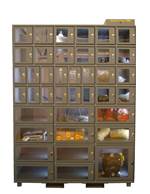A Simple Plan for Environmentally-Responsible Manufacturing
There are many common sense approaches to improving your shop that will not only reduce your carbon footprint, but also your production costs
Going green, or becoming an environmentally-conscious shop, may sound like a daunting task. However, the truth is that there are many common sense approaches to improving your shop that will not only reduce your carbon footprint, but also your production costs. To evaluate where you can make some quick gains, we suggest the simple three-step philosophy outlined below.
1. Reduce. The idea is to simply lessen the use of other things. For example, cutting tool suppliers focus their efforts on producing carbide with chemistry and geometries that make machining more efficient. This translates into fewer inserts required to machine a part, reduced scrap, less energy usage to create the part and less coolant.
Reducing usage also involves optimization of the whole system. It is not enough to just plug in the machine parameters and cutting feeds/speeds that are supplied in the literature. For example, you can drive a car at 2 mph or at 100 mph. It works at both speeds, but the most efficient operating speed is going to be somewhere between those two numbers.
There are some clues as to whether you are operating efficiently or not. Obviously, you can monitor your own energy usage by watching your outside meter or by actually putting meters on the individual machines. Examine what happens to the energy consumption when you alter the machining processes.
Additionally, if you find that your scrap rates are higher than normal, you need to work on re-examining the overall operation—including the equipment, tools and process. Your cutting tool supplier can work with you to optimize your operations for quality and productivity gains.
2. Re-use. Although first choice is to machine without the use of coolant, there are going to be instances where it is necessary. Most machines today should be of the enclosed variety, which conform to OSHA standards. No one wants coolant spraying all over their shop floor for both environmental and safety reasons. With enclosed equipment, the coolant can be reclaimed, filtered and re-used.
Additionally, when applied properly, today’s advanced carbide can be used over and over and over. This again relates to optimization of the process. Get the most out of your inserts through smart application and then recycle them.
3. Recycle. Today there is no excuse for not recycling your carbide as almost every major cutting tool supplier has a program in place. With many of these suppliers actually buying back the used carbide, it is both a wise financial and environmental choice.
For example, when an operator replaces a carbide insert, about 95 percent of the carbide is still intact and capable of being recycled. Of this carbide, tungsten comprises 75 percent of the content. Tungsten is a finite resource with the interesting ability to be recycled infinitely, reducing our reliance upon mining of this rare earth element.
With this approach, you can see that environmental-responsibility and productivity can go hand-in-hand, putting both black and green into your bottom line.
Related Content
-
It Starts With the Part: A Plastic Part Checklist Ensures Good Mold Design
All successful mold build projects start with examining the part to be molded to ensure it is moldable and will meet the customers' production objectives.
-
Machining Center Spindles: What You Need to Know
Why and how to research spindle technology before purchasing a machining center.
-
Moldmakers Deserve a Total Production Solution
Stability, spindle speed and software are essential consideration for your moldmaking machine tool.
.png;maxWidth=970;quality=90)







.png;maxWidth=300;quality=90)



